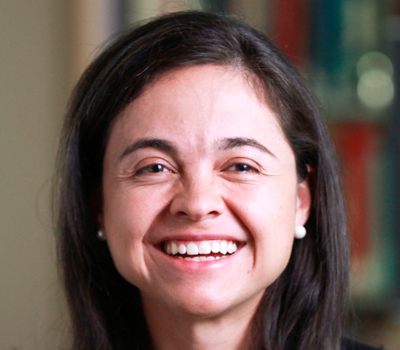Using light and electromagnetic fields to control atoms at the quantum level
The world of quantum mechanics is proving to be so difficult that without proper guidance from theorists, experimentalists would not have the necessary direction to make many of the discoveries that have occurred in recent years. Dr. Ana Maria Rey is performing computer calculations and developing analytical models of atoms cooled by lasers to .0000001 degree and lower of a Kelvin to understand the behavioral nature of those atoms as it translates to understanding the nature of quantum physics. The trapping of atoms in crystals of light, which are periodic traps formed by the interface of laser beams, provides insight into the behavior of electrons in solid state materials. This fundamental understanding of physics and quantum mechanics will enable researchers to develop a vast new range of advanced materials (such as improved high-temperature superconductors that conduct electricity without dissipation) with applications in transportation, defense, and high-performance electric motors, among other fields. Dr. Rey's work at the atomic scale is providing the basic building blocks for the development of a quantum computer, a machine that operates beyond the scope of a classical computer, and is improving atomic clocks, which have applications in GPS and satellites for communications and defense. Dr. Rey's research, while theoretical and laboratory based, is giving necessary direction to experimentalists and has the potential to revolutionize our understanding of real materials and to create new synthetic ones with no real analog in nature.
Dr. Ana Maria Rey, JILA Fellow and Associate Professor of Physics at the University of Colorado, is developing ways to engineer fully-controllable quantum systems based around ultra-cold atoms or molecules that mimic the behavior of electrons in solid state materials. At room temperature, atoms and molecules in the air move too rapidly (300 meters per second, or the speed of sound). At those velocities, studying and controlling atoms is very difficult since their rapid motion substantially limits the observational time for any reasonably-sized apparatus. Moreover, at room temperature atoms behave classically; think of billiard balls that collide with one another. When the atoms are cooled down to extremely cold temperatures however, below .0000001 degree of a Kelvin, they slow down to speeds at which they can be controlled and manipulated. Furthermore, at ultra-cold temperatures atoms start to behave exhibiting quantum behavior, more like waves rather than particles. The cooling of alkali atoms has already resulted in two Nobel prizes in physics, one in 1997 and the other in 2001, which highlights the importance this research has on the scientific community.
Regardless of developments in this field, the investigation of the most complex and interesting physics using ultra-cold atoms still requires temperatures far below those which are currently attainable in the laboratory. Dr. Rey's current research works with the many processes and difficulties involved with cooling atoms. She is also trying to explore richer systems beyond the traditional use of alkali metals (first column of the periodic table) which could relax the low temperature limitations required for observing interesting quantum behavior and adjusting for the challenges associated with this research.
-
When the cooling of atoms was first introduced, researchers used alkali metals, those in the first column of the periodic table. They were chosen because of their simple atomic structure, which allowed researchers to model very well how atoms behave when they are illuminated by light. However, the same simplicity that allows these atoms to be cooled with relative ease also limits the physics that can be explored. Dr. Rey is thus exploring the use of more complicated atoms, and even molecules with richer internal structure. Although these more complicated systems are harder to control and manipulate, they can offer a new arena for the exploration of richer quantum phenomena not attainable using simpler atoms.
-
Along with the exploration of quantum behavior, Dr. Rey is working with atoms in the second column of the periodic table, which have one extra valence electron than alkali atoms, and with molecules comprised of two atoms. In collaboration with experimentalists at JILA, an interdisciplinary institute for research in the physical sciences, this team is starting to demonstrate that these systems can in fact allow us to create better clocks, better computers and better understanding of magnetic materials. The potential of these systems to impact our understanding of the quantum world is just starting and many aspects need yet to be explored.
Bio
Dr. Rey's interest in physics began at an early age, in her hometown of Bogota, Colombia, with an inherent love for mathematics. Finding solutions to problems grew and developed into one of her favorite pastime. By the time she reached six years old; she was enthralled by numbers. Her understanding of the potential of mathematics changed when Dr. Rey was introduced to basic physics. It was at this point she realized that numbers had more potential than being simply theoretical and abstract, they could be applied as a tool through physics to find solutions for something tangible and real, all of nature's problems! It was at this point that Dr. Rey decided she wanted to become a physicist, and she embarked on the path towards this career. Dr. Rey is a believer that every system in nature is ruled by an overarching, guiding equation, and is working to uncover just how far our understanding into these complicated equations can go.
Dr. Rey's research interests are in the scientific interface between atomic, molecular and optical physics, condensed matter physics and quantum information science. Specifically, on ways of developing new techniques for controlling quantum systems and then using them in various applications ranging from quantum simulations/information to time and frequency standards. One of Dr. Rey's research goals is to engineer fully controllable quantum systems capable to mimic desired real materials as well as to develop advanced and novel measurement techniques capable of probing atomic quantum systems at the fundamental level.


